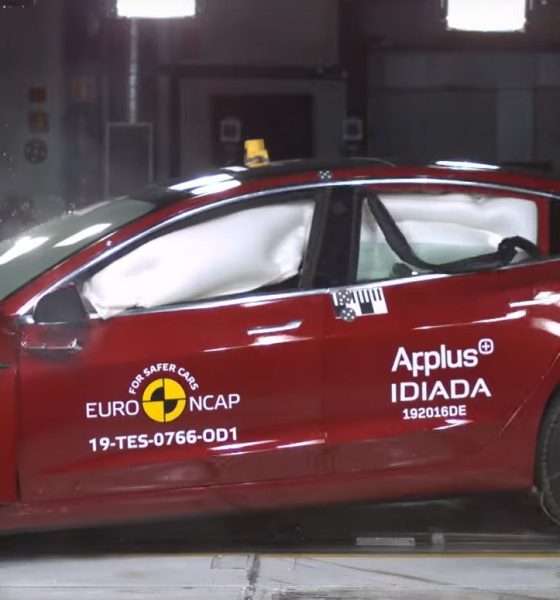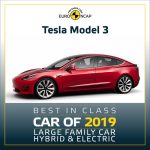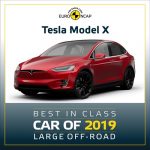

News
Tesla Model 3, Model X take top honors in Euro NCAP Best in Class Cars 2019 List
The European New Car Assessment Programme or more popularly known as Euro NCAP published its “Best of the Best of 2019” list and the Tesla Model X and Model 3 are among the Best In Class for 2019.
The Tesla Model 3 was named the best vehicle in the Large Family Car category and shared the spotlight with the BMW 3 Series, despite edging out the Bavarian sedan in Safety Assist by receiving a score of 94 versus BMW’s 76. Euro NCAP also awarded the Tesla Model X all-electric SUV as the best Large Off-Road vehicle, beating out the SEAT Tarraco which took home second place.
The awards come with prestige as Euro NCAP is one of the most respected car safety watchdogs, providing consumers with an independent and realistic safety assessment of some of Europe’s most popular vehicles. Established in 1997 and modeled after the car assessment program of the U.S. National Highway Traffic Safety Administration, the program has since served as a catalyst when it comes to improving vehicle safety. The Euro NCAP overall safety rating was introduced in 2009 and evaluates the safety of the vehicle based on four areas: Adult Occupant Protection, Child Occupant Protection, Pedestrian Protection, and Safety Assist.
The Euro NCAP safety tests simulate possible real-life accidents that may cause serious injuries or even death of vehicle occupants. For example, the frontal impact test simulates accidents such as head-on collisions where the vehicle’s structure, how its parts safely absorb different crash forces, and whether the vehicle’s design leaves enough space in the passenger compartment during big collisions are looked into because these factors can spell the difference between life and death. Euro NCAP also tests vehicles to see if their child restraint systems are properly designed and can keep the child safe during vehicular accidents.
The category on Vulnerable Road User tests how other users such as pedestrians and cyclists are at risk of injuries when they are hit by the vehicles undergoing testing. The safety watchdog also scores driver-assist technologies that help lower the risk of accidents on the road and also mitigate injuries.
As the Model 3 and Model X rule their respective categories in the Best In Class of 2019 list just helps prove that Tesla is on the right path in building safe vehicles from the ground up, plus developing technologies such as its Autopilot and Full Self-Driving features that push vehicle safety to the next level.
To be included in Euro NCAP Best in Class Cars Of 2019 list is a feather in any automotive manufacturer’s cap. It means the vehicles are among the safest on the road today.
In mid-2019, the car safety watchdog awarded the Tesla Model 3 sedan 5 stars in all of its safety categories, which set the bar higher for vehicles in its class.
“Tesla has done a great job of playing the structural benefits of an electric vehicle to its advantage. The Tesla Model 3 achieved one of the highest Safety Assist scores we have seen to date,” said Thatcham Research head of research Matthew Avery.
The Model 3 has shown off its safety features in the real world, most recently protecting a driver after an SUV landed on top of a Model 3 during a multi-car pile-up in China.
The Model 3’s bigger sibling, the Model X, is also considered a champ by Euro NCAP as it awarded Tesla’s flagship SUV a 5-Star Safety Rating in December.
Other Best In Class for 2019 winners include Mercedes-Benz CLA for the Small Family Car category with Mazda 3 as its runner-up. The Subaru Forester ruled the Small Off-Road/MPV category with the Volkswagen T-Cross and the Mazda CX-30 sharing the second spot. The best in the Supermini category was given to the Audi A1 and Renault Clio with the Ford Puma given the runner-up honors.
Check out the video footage below showing Euro NCAP’s Best In Class Cars of 2019:

Elon Musk
Elon Musk and Tesla AI Director share insights after empty driver seat Robotaxi rides
The executives’ unoccupied tests hint at the rapid progress of Tesla’s unsupervised Robotaxi efforts.

Tesla CEO Elon Musk and AI Director Ashok Elluswamy celebrated Christmas Eve by sharing personal experiences with Robotaxi vehicles that had no safety monitor or occupant in the driver’s seat. Musk described the system’s “perfect driving” around Austin, while Elluswamy posted video from the back seat, calling it “an amazing experience.”
The executives’ unoccupied tests hint at the rapid progress of Tesla’s unsupervised Robotaxi efforts.
Elon and Ashok’s firsthand Robotaxi insights
Prior to Musk and the Tesla AI Director’s posts, sightings of unmanned Teslas navigating public roads were widely shared on social media. One such vehicle was spotted in Austin, Texas, which Elon Musk acknowleged by stating that “Testing is underway with no occupants in the car.”
Based on his Christmas Eve post, Musk seemed to have tested an unmanned Tesla himself. “A Tesla with no safety monitor in the car and me sitting in the passenger seat took me all around Austin on Sunday with perfect driving,” Musk wrote in his post.
Elluswamy responded with a 2-minute video showing himself in the rear of an unmanned Tesla. The video featured the vehicle’s empty front seats, as well as its smooth handling through real-world traffic. He captioned his video with the words, “It’s an amazing experience!”
Towards Unsupervised operations
During an xAI Hackathon earlier this month, Elon Musk mentioned that Tesla owed be removing Safety Monitors from its Robotaxis in Austin in just three weeks. “Unsupervised is pretty much solved at this point. So there will be Tesla Robotaxis operating in Austin with no one in them. Not even anyone in the passenger seat in about three weeks,” he said. Musk echoed similar estimates at the 2025 Annual Shareholder Meeting and the Q3 2025 earnings call.
Considering the insights that were posted Musk and Elluswamy, it does appear that Tesla is working hard towards operating its Robotaxis with no safety monitors. This is quite impressive considering that the service was launched just earlier this year.
Elon Musk
Starlink passes 9 million active customers just weeks after hitting 8 million
The milestone highlights the accelerating growth of Starlink, which has now been adding over 20,000 new users per day.

SpaceX’s Starlink satellite internet service has continued its rapid global expansion, surpassing 9 million active customers just weeks after crossing the 8 million mark.
The milestone highlights the accelerating growth of Starlink, which has now been adding over 20,000 new users per day.
9 million customers
In a post on X, SpaceX stated that Starlink now serves over 9 million active users across 155 countries, territories, and markets. The company reached 8 million customers in early November, meaning it added roughly 1 million subscribers in under seven weeks, or about 21,275 new users on average per day.
“Starlink is connecting more than 9M active customers with high-speed internet across 155 countries, territories, and many other markets,” Starlink wrote in a post on its official X account. SpaceX President Gwynne Shotwell also celebrated the milestone on X. “A huge thank you to all of our customers and congrats to the Starlink team for such an incredible product,” she wrote.
That growth rate reflects both rising demand for broadband in underserved regions and Starlink’s expanding satellite constellation, which now includes more than 9,000 low-Earth-orbit satellites designed to deliver high-speed, low-latency internet worldwide.
Starlink’s momentum
Starlink’s momentum has been building up. SpaceX reported 4.6 million Starlink customers in December 2024, followed by 7 million by August 2025, and 8 million customers in November. Independent data also suggests Starlink usage is rising sharply, with Cloudflare reporting that global web traffic from Starlink users more than doubled in 2025, as noted in an Insider report.
Starlink’s momentum is increasingly tied to SpaceX’s broader financial outlook. Elon Musk has said the satellite network is “by far” the company’s largest revenue driver, and reports suggest SpaceX may be positioning itself for an initial public offering as soon as next year, with valuations estimated as high as $1.5 trillion. Musk has also suggested in the past that Starlink could have its own IPO in the future.
News
NVIDIA Director of Robotics: Tesla FSD v14 is the first AI to pass the “Physical Turing Test”
After testing FSD v14, Fan stated that his experience with FSD felt magical at first, but it soon started to feel like a routine.

NVIDIA Director of Robotics Jim Fan has praised Tesla’s Full Self-Driving (Supervised) v14 as the first AI to pass what he described as a “Physical Turing Test.”
After testing FSD v14, Fan stated that his experience with FSD felt magical at first, but it soon started to feel like a routine. And just like smartphones today, removing it now would “actively hurt.”
Jim Fan’s hands-on FSD v14 impressions
Fan, a leading researcher in embodied AI who is currently solving Physical AI at NVIDIA and spearheading the company’s Project GR00T initiative, noted that he actually was late to the Tesla game. He was, however, one of the first to try out FSD v14.
“I was very late to own a Tesla but among the earliest to try out FSD v14. It’s perhaps the first time I experience an AI that passes the Physical Turing Test: after a long day at work, you press a button, lay back, and couldn’t tell if a neural net or a human drove you home,” Fan wrote in a post on X.
Fan added: “Despite knowing exactly how robot learning works, I still find it magical watching the steering wheel turn by itself. First it feels surreal, next it becomes routine. Then, like the smartphone, taking it away actively hurts. This is how humanity gets rewired and glued to god-like technologies.”
The Physical Turing Test
The original Turing Test was conceived by Alan Turing in 1950, and it was aimed at determining if a machine could exhibit behavior that is equivalent to or indistinguishable from a human. By focusing on text-based conversations, the original Turing Test set a high bar for natural language processing and machine learning.
This test has been passed by today’s large language models. However, the capability to converse in a humanlike manner is a completely different challenge from performing real-world problem-solving or physical interactions. Thus, Fan introduced the Physical Turing Test, which challenges AI systems to demonstrate intelligence through physical actions.
Based on Fan’s comments, Tesla has demonstrated these intelligent physical actions with FSD v14. Elon Musk agreed with the NVIDIA executive, stating in a post on X that with FSD v14, “you can sense the sentience maturing.” Musk also praised Tesla AI, calling it the best “real-world AI” today.










